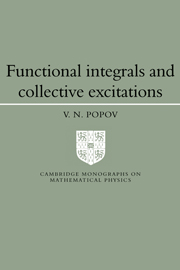Book contents
- Frontmatter
- Contents
- Preface
- Part I Functional integrals and diagram techniques in statistical physics
- 1 Functional integrals in statistical physics
- 2 Functional, integrals and diagram techniques for Bose particles
- 3 Functional integrals and diagram techniques for Fermi particles
- 4 Method of successive integration over fast and slow variables
- Part II Superfluid Bose systems
- Part III Plasma and superfluid Fermi systems
- Part IV Crystals, heavy atoms, model Hamiltonians
- References
- Suggested further reading
- Index
1 - Functional integrals in statistical physics
Published online by Cambridge University Press: 01 June 2011
- Frontmatter
- Contents
- Preface
- Part I Functional integrals and diagram techniques in statistical physics
- 1 Functional integrals in statistical physics
- 2 Functional, integrals and diagram techniques for Bose particles
- 3 Functional integrals and diagram techniques for Fermi particles
- 4 Method of successive integration over fast and slow variables
- Part II Superfluid Bose systems
- Part III Plasma and superfluid Fermi systems
- Part IV Crystals, heavy atoms, model Hamiltonians
- References
- Suggested further reading
- Index
Summary
Functional integration is one of the most powerful methods of modern theoretical physics. The functional integration approach to systems with an infinite number of degrees of freedom turns out to be very suitable for the introduction and formulation of the diagram perturbation theory in quantum field theory and statistical physics. This approach is simpler than that using an operator method.
The application of functional integrals in statistical physics allows one to derive numerous interesting results more quickly than when using other methods. The theories of phase transitions of the second kind, superfluidity, superconductivity, lasers, plasma, the Kondo effect, the Ising model – a list of problems which is far from complete, for which the application of the functional integration method appears to be very fruitful. In some of the problems, it allows us to give a rigorous proof of results obtained by other methods. If there is a possibility of an exact solution, the functional integration method gives a simple way to obtain it. In problems far from being exactly solvable (for example, the general theory of phase transitions), the application of functional integrals helps to build up a qualitative picture of the phenomenon and to develop the approximative methods of calculations.
Functional integrals are especially useful for the description of collective excitations, such as plasma oscillations in the system of particles with Coulomb interaction, quantum vortices and long-wave phonons in superfluidity and superconductivity, collective modes in 3He-type systems and in 3He−4He mixtures.
Information
- Type
- Chapter
- Information
- Functional Integrals and Collective Excitations , pp. 3 - 4Publisher: Cambridge University PressPrint publication year: 1988
